Dell U3011 Review: Dell's New 30-inch Flagship
by Brian Klug on January 13, 2011 9:17 PM ESTViewing Angles
The U3011 has superb viewing angles, just like we've grown accustomed to seeing from IPS panels. Even at the far extreme horizontally, there's none of the purple I'm used to seeing from TN panels as you move off-axis. In the vertical direction, I saw the same thing with almost nothing to complain about. I did notice some glare at the extreme angles, but again that's dependent on where you're sitting and where light sources are located.
I think this is an excellent opportunity to talk about IPS graininess, something we really haven't discussed before. Of the IPS panels I've used to date, all of them have had some high frequency grain on the surface from a combination of coating and interference at the interface. Thankfully the U3011 has a combination antireflection coating and hard coating, and subjectively there seems to be less grain than I've seen on other displays.
Color Quality
Next up are the ever-important color quality metrics. As usual, we report two main quality metrics: color accuracy (Delta-E) and color gamut. Color gamut refers to the range of colors the display is able to represent with respect to some color space. In this case, our reference is the AdobeRGB 1998 color space, which is larger than the sRGB color space. Our percentages are thus reported with respect to AdobeRGB 1998, and larger is generally better unless you're dealing with sRGB content and colorspace-unaware software.
Color accuracy (Delta E) refers to the display’s ability to display the correct color requested by the GPU and OS. The difference between the color represented by the display, and the color requested by the GPU is our Delta-E, and lower is better here. In practice, a Delta E under 1.0 is perfect - the chromatic sensitivity of the human eye is not great enough to distinguish a difference. Moving up, a Delta E of 2.0 or less is generally considered fit for use in a professional imaging environment - it isn’t perfect, but it’s hard to gauge the difference. Finally, Delta E of 4.0 and above is considered visible with the human eye. Of course, the big consideration here is frame of reference; unless you have another monitor or some print samples like a Gretag Macbeth color checker card to compare your display with, you might not notice.
As I mentioned in our earlier reviews, we’ve updated our display test bench. We’ve deprecated the Monaco Optix XR Pro colorimeter in favor of an Xrite i1D2 since there are no longer up-to-date drivers for modern platforms. We're trying to find an i1Pro to use as well.
For these tests, we calibrate the display and try to obtain the best Delta-E we can get at both 200 nits of brightness for normal use, and 100 nits for print brightness. We target D65 and a gamma of 2.2, but sometimes the best performance lies at native temperature and another gamma, so we try to find what absolute absolute best-case performance for each display. We also take an uncalibrated measurement to show performance out of the box using either the manufacturer supplied color profile, or a generic one with no LUT data. For all of these, dynamic contrast is disabled, and displays are left to settle for a half hour after making changes. The U3011 is CCFL-backlit, and I used a settle time of 30 minutes accordingly.
First up is uncalibrated Delta-E performance. For this test, I took the monitor out of the box, connected it over DisplayPort, adjusted to 200 nits, and ran our usual GMB color checker test. Results aren't that great, sadly.
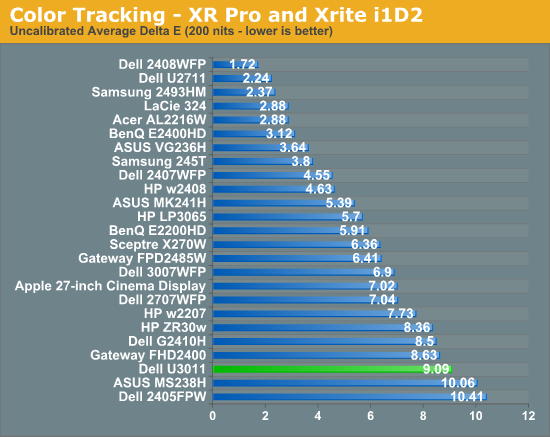
I mentioned earlier that the U3011 we got from Dell for testing came with no factory calibration report. After checking up with them, we learned this is a pre-production unit identical to what's shipping now, minus that factory calibration. That's something we can live with, especially since we recommend every display be calibrated, but still unnerving.
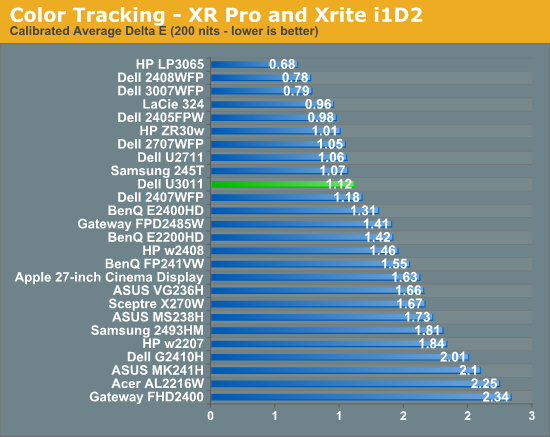
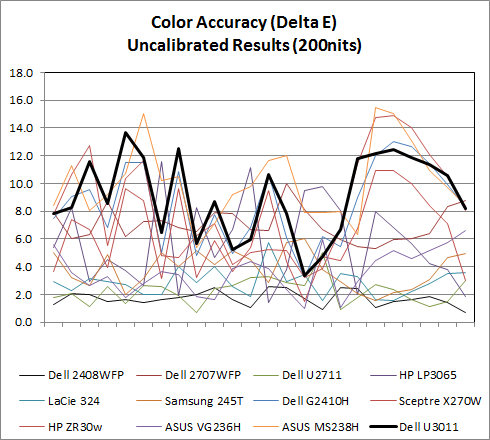
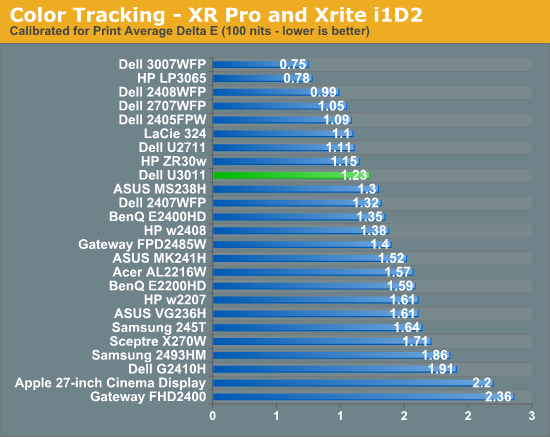
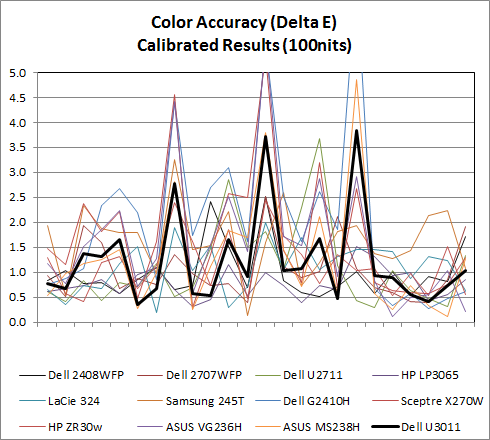
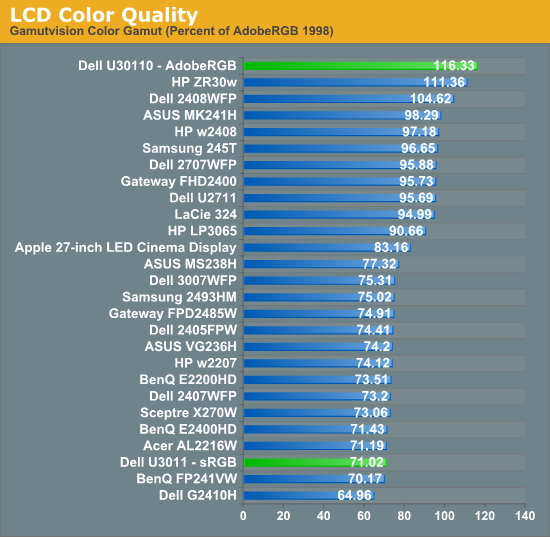

AdobeRGB Mode
sRGB Mode
Calibrated Delta-E is very good, though I'm still surprised the U3011 can't get under 1.0 on our tests. I'm starting to suspect that our i1D2 isn't quite as good as the Monaco Optix XR Pro, and have started looking for an i1Pro spectroradiometer as a result so we can have something more accurate going forward. That said, performance is still more than adequate for professional work. These two calibrations were performed in the sRGB mode at D65.
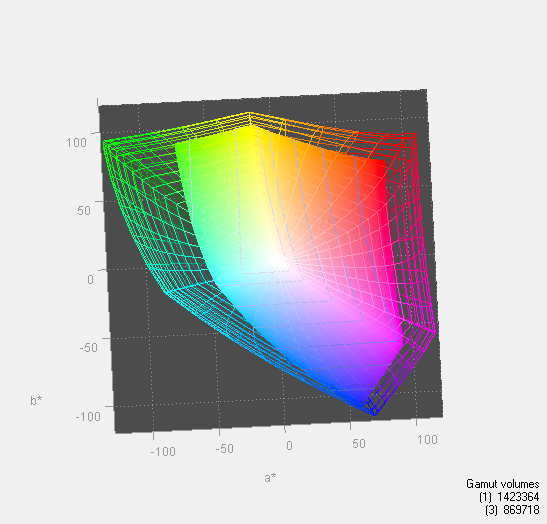
In addition, the U3011 has modes for AdobeRGB color space and sRGB in the OSD, something extremely useful for doing work and not getting oversaturation in applications that lack color management. You can immediately see the effect of those two modes in the color gamut measure above. Letting the monitor free to use its entire gamut of color, it leads the pack. Turn sRGB mode on, and it clamps down just nicely. 116.33% is also shockingly close to Dell's advertised 117% coverage of CIE 1796 (AdobeRGB), which is awesome to see confirmed above.








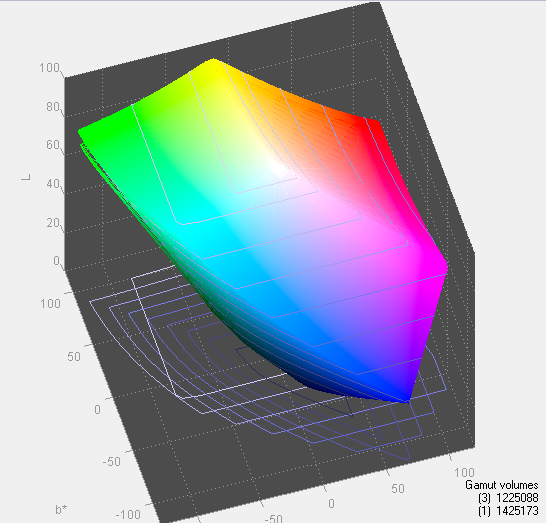
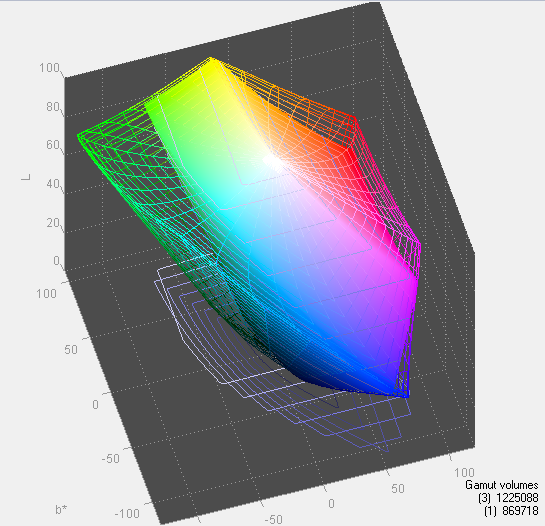








123 Comments
View All Comments
dimensional - Wednesday, June 1, 2011 - link
This U3011 is large enough to be appropriate for a wall mount. Yet, it seems nobody is asking about the problem with the screws for the mount being way too small and short. Because of the problem, I will need to replace those screws with longer ones just to be able to at least secure the screws most of the way through the holes after installing a thin wall mount onto it. It makes no sense for them to not give you any longer screws so you can mount the huge monitor. Specially after spending a small fortune for the monitor in the first place.ab_ba - Tuesday, February 7, 2012 - link
The review mentions some speckling on this screen. I have an NEC PA271 but the speckling is too annoying. Can anybody comment if it will be better on this screen, or on the HP ZR30?bjnicholls - Monday, November 26, 2012 - link
After reading the reviews for the NEC, HP, and Dell 30" monitors, I decided to give the Dell a try. I currently have an older NEC 3090wqxi that's developing some blotchy gray areas along the upper left edge of the display, and I need a replacement (perhaps letting me get the old NEC repaired if the gray is perhaps a cleanable dust layer).I found a price under $1K from Amazon and decided to give the U3011 a shot. It arrived today and as soon as I tuned it on I was disappointed. On my unit, there was an immediately obvious green shift on the left third of the screen, and that color inconsistency didn't improve at all after the display was warmed up. Nor is it affected by switching between the built-in profiles. Looking at a white screen, the Dell's luminosity is also very inconsistent; my old NEC is still dramatically better. I'm just here to weigh in as a professional graphic designer and photographer. If you care about color accuracy don't bother with the Dell U3011. There's a reason it's half the price of the current NEC PA301w. I suspect that a photographer or designer would be better off spending the price of the U3011 on the smaller 27" NEC PA201w.
Maybe I just got a bad sample, but I very much doubt that the average U3011 is much better and I'm not going to try exchanging it. Despite user reviews and relatively positive articles like this one, I don't believe the Dell U3011 is viable for professional level work. Dell's inclusion of a "calibration" report is really worthless, since it's obviously a spot calibration and doesn't demonstrate any level of consistency for color across the display.